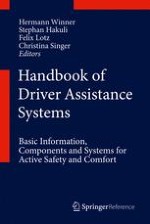Abstract
The attractive power of driving motor vehicles results from the expansion of human mobility far beyond the natural physiological capabilities of people such as radius of action, power, speed, transport capacity, independence of timing and choosing routes, etc. Unfortunately, the enormous kinetic energy involved in the dynamic process of driving is coupled with an inherent danger of loss of control.
Both human factors and technical features of the road traffic system combined with their interactive compatibility decisively influence primary safety, i.e., accident prevention potential.
Science established a successful method of gaining and comprehensively representing knowledge by derivation of empirical models in terms of qualitative (descriptive) and particularly quantitative (mathematical) models. Such modeling approaches for human driver behavior in road traffic with scope on specific capabilities and limitations are reported on, aiming at their challenges for driver assistance systems.
As focal points of the following discussion, the predictability principle (in control systems theory terminology, this could be named “anticipatory observability criterion”), the acquisition of driving skills, and the quantification of collective and individual human driving competence will be highlighted. The gaps between intrinsic human performance limitations and physico-technical constraints of vehicle, road, and traffic-environment characteristics open up the most promising realms for the development of driver assistance systems.
